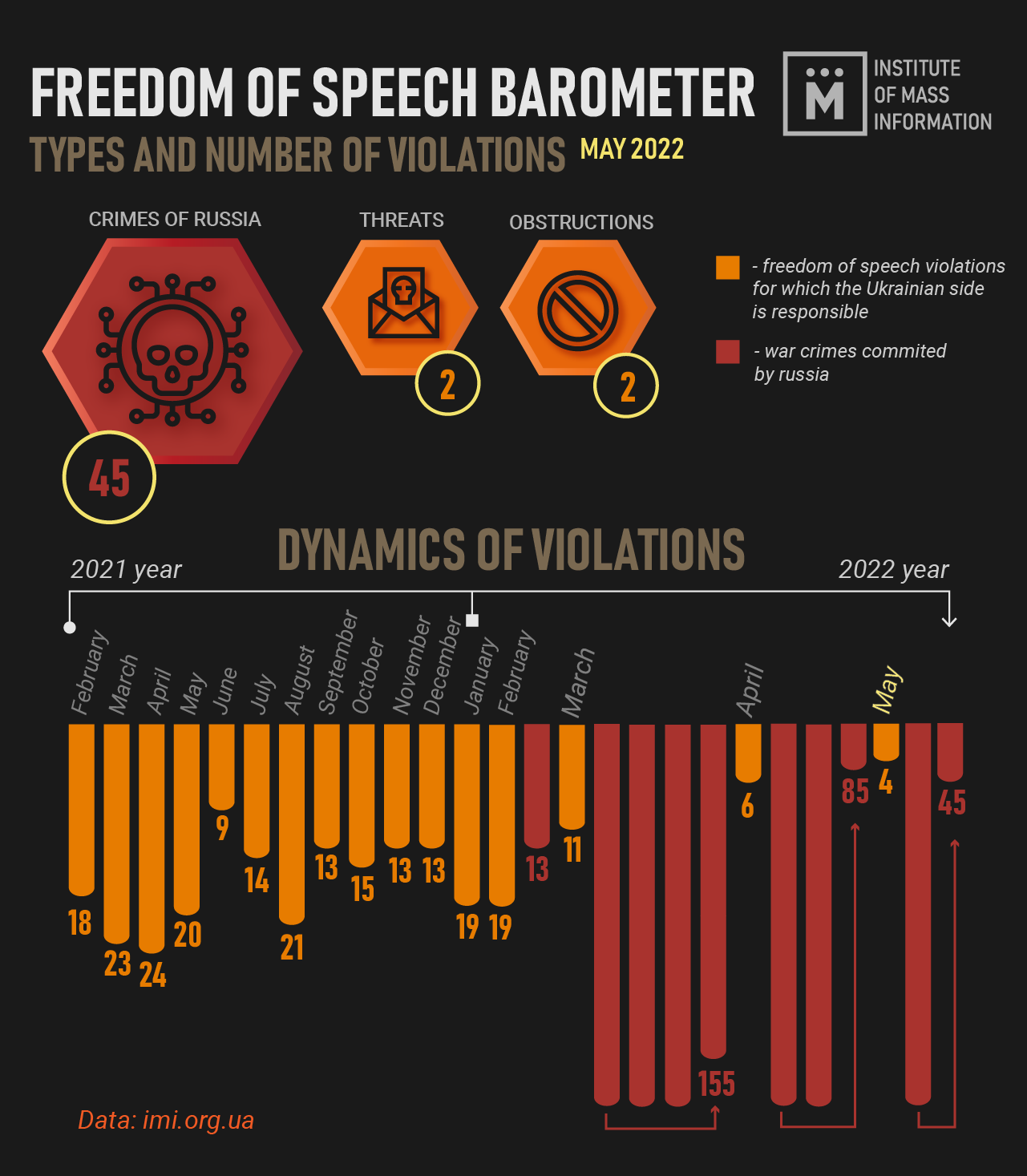49 crimes against freedom of speech in Ukraine have been recorded by the Institute of Mass Information in May. Of these, 45 were committed by russia against the media and journalists on Ukrainian territory.
These crimes include murder, wounding and abduction of journalists, shelling of filming crews and TV towers, threats, cyber attacks on Ukrainian media websites, disabling Ukrainian broadcasting, media outlets closing due to russian shelling, inability to work and print newspapers due to infrastructure destruction, and more. At the same time, IMI has recorded four cases of freedom of speech violations for which the Ukrainian side is responsible.
These are the monitoring data of the Institute of Mass Information.

Namely, on May 30, journalist of the French BFMTV TV channel Frederic Leclerc-Imhoff was killed by russian shelling in Luhansk region. Two of his colleagues were also injured by the shelling – Maxim Brandstetter received a shrapnel wound to his left thigh and a concussion, Oksana Leuta suffered a concussion. The journalists were working on a story about evacuation from Lysychansk, they were in an armored evacuation vehicle during the shelling.
Two more journalists were injured as they came under russian fire on May 28 near the bridge to Severodonetsk (Luhansk region). British journalist Alex Chan Tsz Yuk was injured, and Ukrainian fixer Mykola Pastukh received a shrapnel wound to his right arm.
In May, the russian forces abducted Oleksiy Vorontsov, a Suspilne Kherson engineer, in the temporarily occupied Kherson. As of now, the premises of “Suspilne Kherson” are controlled by the occupying forces of the russian federation. The occupiers have repeatedly tried to find the files of the branch’s employees in order to recruit, interrogate and obtain information from them. On May 21, it became known that the russian occupation forces had released Oleksiy Vorontsov. He is alive and at home in the temporarily occupied Kherson.
Journalists from Hromadske, the Estonian ERR, the Estonian Postimees, the German Welt, Zaborona, AFP, TSN, Radio Liberty, and ICTV have come under russian fire in the Donbas and in Kharkiv region.
IMI also recorded cases of threats that journalists received from russia. These were mostly letters sent to the editorial email addresses. In their letters, the russians threatened journalists with trials, imprisonment, and being held accountable for “russophobic fakes,” and advised them to pack warm clothes for Siberia. Threats about the use of nuclear weapons became a novelty in May. In particular, such a threat was received by the editorial board of the Center for Investigative Journalism “Syla Pravdy.” The letter threatened to fire such weapons on Halychyna and Volhyn. The text was accompanied by various images depicting russian soldiers.
In addition, the russians continue to carry out cyber attacks on Ukrainian media websites, although the intensity has somewhat decreased. In particular, in May, DDoS attacks on the websites of Odesa.Online and NikVesti, which worked intermittently for several days, were recorded.
russian crimes against journalists and the media have been recorded in eight regions of Ukraine. Journalists most often risked their lives in Donetsk and Luhansk regions, where one journalist was killed, four were injured, and came under fire this month.
The freedom of speech situation in Ukraine for which the Ukrainian side is responsible
In May, IMI has recorded four cases of violations of freedom of speech in Ukraine for which the Ukrainian side was responsible. These are cases of physical aggression against journalists: two cases of obstruction and threats.
Journalists were threatened, in particular, by a moscow patriarchate supporter and by unknown individuals. Namely, “Chetverta Vlada” journalist Alla Maksymchuk received a threat of “lustration” from a moscow patriarchate supporter. The incident occurred while the journalist was preparing a story about the community’s struggle for the opportunity to go to a church controlled by the OCU, not the moscow church.
Serhiy Zaraiskyy, journalist from Chernivtsi and head of the BookInfo portal, said that an unknown person had threatened to kill him and destroy his home. According to the journalist, the threats came to his phone after the publication of the article titled “NABU should take a close look at Osachuk, Head of the Chernivtsi Regional State Administration, for forging the papers of military units and covering up smuggling schemes at the border.”
Journalists in Kropyvnytsky and Zaporizhzhia have had their work obstructed. Namely, in Zaporizhia, law enforcement officers banned journalists from several media outlets (061.ua, correspondents from 1+1 and Channel 5) from filming civilian facilities destroyed by russian bombing. The journalists arrived at the site a few hours after the bombing. However, the police did not allow them to film despite the legal timing. It will be recalled that representatives of the authorities and of the Media Movement journalistic community agreed that journalists can publish photos and videos of military facilities 12 hours after the end of hostilities, and 3 hours later in the case of civilian facilities.
Violations have been recorded in four regions: Rivne, Kropyvnytsky, Chernivtsi, and Zaporizhzhia.
Learn more here.
